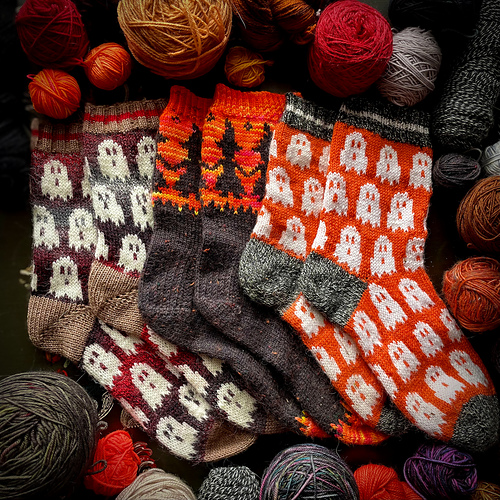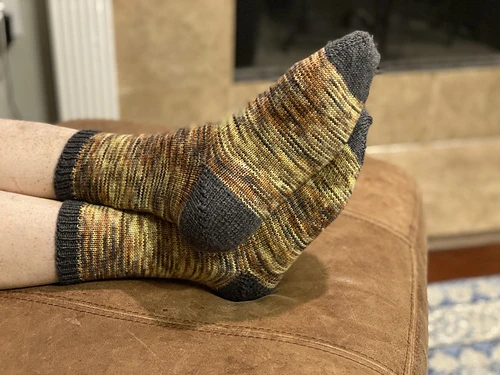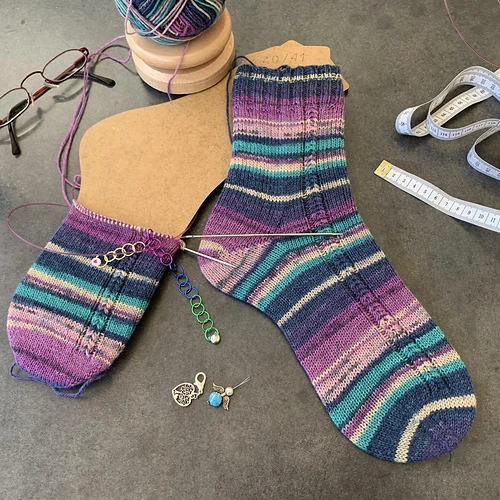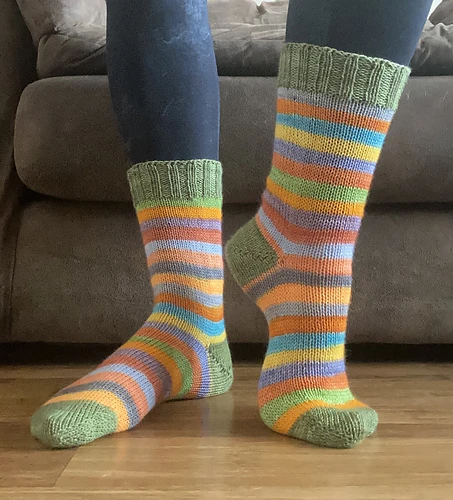
It’s officially Socktober, and if you’re anything like us, that means you’re daydreaming about cozy toes and warm woolly layers.
This month, we’re putting all our focus on the art (and fun!) of sock knitting. Whether you’ve been cranking out socks for years or just starting to dip your toes into this world, we’ve got a few tips, some favorite yarn picks, and a handful of patterns to inspire your next pair.
Sock Knitting Tips & Tricks
Start Strong with a Good Cast-On: A snug cast-on is key for socks that stay up without squeezing your legs. Try the German Twisted Cast-On or the Old Norwegian Cast-On for more elasticity.
Project idea: Shadow Wrap Heel Socks
This pattern is a fantastic starting point for knitters of all levels, with options for both toe-up and cuff-down construction.

© ATexasYarn
Don’t Skip the Swatch: Swatching for socks helps ensure they fit snugly. If you’re knitting cuff-down, knit a few inches and check your gauge.
Reinforce High-Wear Areas: Hold a second strand of thin yarn like nylon or mohair in high-wear areas (heels and toes) to add durability.
Project idea: Erla Socks
Looking for something truly stunning? The Erla Socks are knit top-down and start with a delicate scalloped edge.

© mietzimaus on Ravelry
Customize the Fit: Toe-up socks are great because you can try them on as you go. Add stitches for more toe space or switch needle sizes for a tighter fit at the cuff.
Is Nylon Essential in Sock Yarn?
For this question, we turned to our in-house textile and fiber expert, Monica. Monica’s take? Nylon isn’t a must. While it can make your socks stronger, Monica believes the construction of the yarn is even more important. She recommends always knitting socks with yarn that has at least three strands (or plies) twisted together and a high twist.
What’s a ply, exactly?
A “ply” refers to each individual strand that’s twisted to make up a single yarn. When a yarn has multiple plies, like three or more, it’s stronger and less likely to wear out because the strands share the load. Plus, high-twist yarns have a tighter spin, making them more resistant to pilling and creating a sturdier fabric overall.
So, while nylon can be a helpful add-in, the number of plies and the twist of the yarn are the real MVPs when it comes to long-lasting socks.
Why Superwash Yarn for Socks?
Socks are meant to be worn and washed a lot. That’s why we often recommend superwash yarn for sock knitting. Superwash wool has been treated to be machine washable on a cool, delicate cycle, so you can toss your socks into the laundry without worrying about felting or shrinking.
Because let’s be real—no one wants a pile of hand-knit socks piling up, waiting for a special hand-wash day. Superwash yarn lets you enjoy your socks more and worry less!
Our Favorite Sock Yarns at Mother Knitter
- Hedgehog Fibres Sock Yarn: 90% superwash merino and 10% nylon, hand-dyed for unique colorways.
- Kelbourne Woolens Perennial: A blend of superwash merino, Suri alpaca, and nylon, offering softness and durability with vibrant colors.
- Sandnes Garn Sisu: 80% superwash wool and 20% nylon, perfect for budget-friendly sock projects.
- Sandnes Garn Strømpegarn (sock yarn): A soft, durable utility yarn reinforced with nylon. This makes it ideal for socks and slippers.
Cast on!
Now’s the perfect time to cast on that new pair you’ve been thinking about, whether it’s a classic cuff-down or a funky toe-up.
We’d love to hear about your favorite sock patterns and yarn picks, too—feel free to pop by the studio or drop us a line with your own tips and tricks!
Don’t forget to tag us on Instagram or share your pictures on our Facebook page. Seeing what you make always brings a smile to our faces, and you just might inspire your fellow knitters and crocheters along the way.


